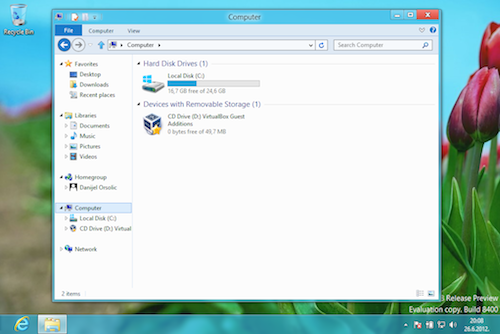Windows 8: Trying to Sit on Two Chairs Could Hurt

My initial impression of the Microsoft Surface tablet had me pretty upbeat about what Microsoft is doing with it and Windows 8, but after watching a few videos such as the one below, showing common users trying to find their way around Windows 8 on a standard desktop computer, I’m seriously beginning to doubt Microsoft’s approach.
In fact, that’s an understatement. Seeing people literally unable to do something even so basic as getting back to a start screen to launch a new application has me thinking that Windows 8 in its current (pre-final in fact) incarnation will be utterly unusable for most PC users.
That would lead me to believe that Windows 8 is primarily being targeted at tablets, but then we have to account for the fact that the standard Windows desktop user interface (now called Aero Lite) is still bundled with Windows 8 even on a tablet, and it is all too easy to launch, even accidentally. The Aero Lite experience on a tablet poses a stark contrast to a smooth Metro experience, and therefore impacts the overall Windows 8 experience.
As Chris Pirillo points out most people probably don’t want to see Aero Lite on a tablet or Metro on a PC. Metro is best suited for a tablet, and Aero is best suited for a PC, or at least it was before it was declawed in Windows 8. If Microsoft wants to offer Aero applications on a tablet they should’ve probably come up with a better approach, perhaps integrating them within the Metro interface if that’s at all possible while maintaining the seamless user experience.
And if it is not possible then the whole idea of trying to bridge these two worlds perhaps doesn’t make all that much sense. Tablets will be tablets, and PCs will be PCs, and they need a dedicated user interface for each. This gets us back to Microsoft Surface, a device which is essentially a combination of the two, and probably represents the best type of device for Windows 8 as what it is. Since you have a touch screen at all times, but also an easily available keyboard with a touchpad you could simultaneously take advantage of both user interfaces on a single device.
Still, the solution doesn’t seem quite so elegant. If sitting by a desk you’ll likely want a bigger screen than what is offered by Surface, meaning that you will connect it to a external screen. At that point you probably wouldn’t find using the touch screen just to navigate the OS as an ideal proposition, yet that remains the best way to deal with Metro UI. Overall, this gives Windows 8 experience the aura of inelegance and awkwardness that is decidedly lacking in Apple’s products, and to some extent in Android tablets. And these are what Microsoft wants to compete with.
This gets me back to my old argument (not that I’m anybody special) about the idea of merging a desktop OS with a tablet OS. With the right implementation of seamless cloud computing the benefits of having a single OS for both form factors diminish significantly. It is seamless access to data that users care about the most, not so much the applications they use to manipulate it, so long as these applications are intuitive and easy to use. Because of this it makes sense for tablets to have exclusively tablet-oriented user interfaces and applications, and for PCs to have standard PC-oriented ones.
As tablets become more capable the tablet applications will catch up in capability as well, until they become as powerful as their PC counterparts. The fact that they are separate applications won’t be an issue. In a contrary, it’s what makes them fit the given form factor most perfectly. Besides, when it comes to OSX and iOS the code bases between the two already have quite a bit in common making it easier for developers to quickly improve the capabilities of iOS applications to the point of matching those on the desktop.
Because of this it still seems as if Apple has the right idea while Microsoft is going in a rather dubious direction, and gambling huge on it.
That said, why not. They’ve got the money to risk, and they’re testing an idea. Regardless of whether Windows 8 fails in the market or not, something good must come out of it. Microsoft Surface, for instance, at the very least shows what a non-Apple tablet could be like, giving OEMs the kick in the shins that they probably needed. It is a slick device in its own right, regardless of the software, and Windows 8 Metro UI is still a pretty good tablet interface.
It almost seems as if Microsoft is betting on everyone quickly switching to tablet computers and not looking back. So long as Aero Lite is hidden from view Windows 8 is a better tablet OS than it is a desktop OS, so its success seems directly proportional to the expansion of tablet computing at the expense of standard PCs. And if Windows 8 does fail on PCs, Microsoft still has Windows 7 to fall back on. After all, when Vista happened, a lot of people stuck out with Windows XP. And Windows 7 is a far better OS to get stuck with for a while. It remains the best OS Microsoft has ever produced.


Comments - 7 Responses to “Windows 8: Trying to Sit on Two Chairs Could Hurt”
Sorry but comments are closed at this time.